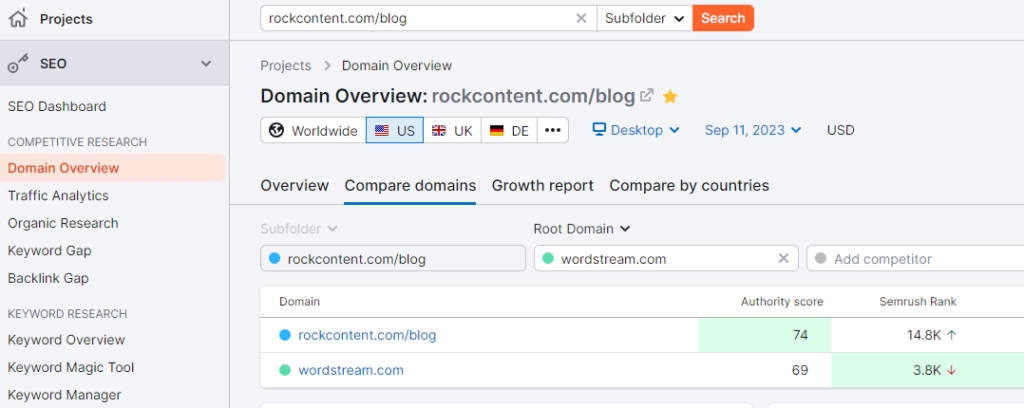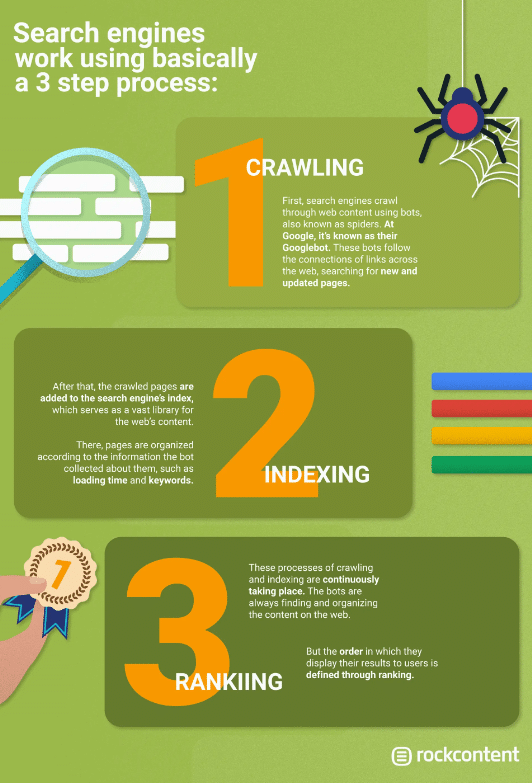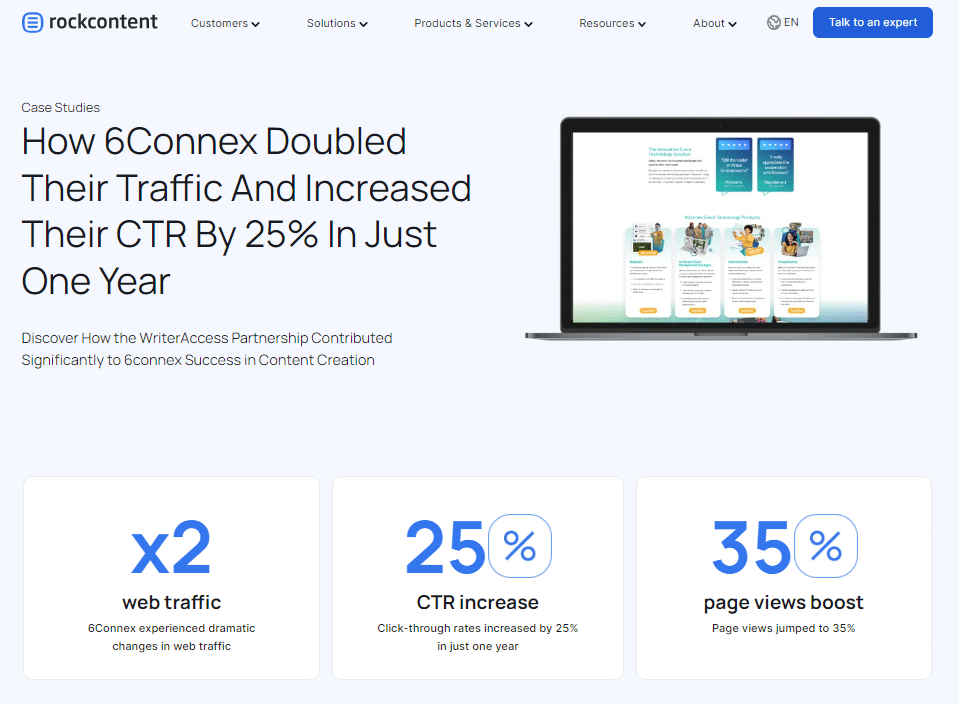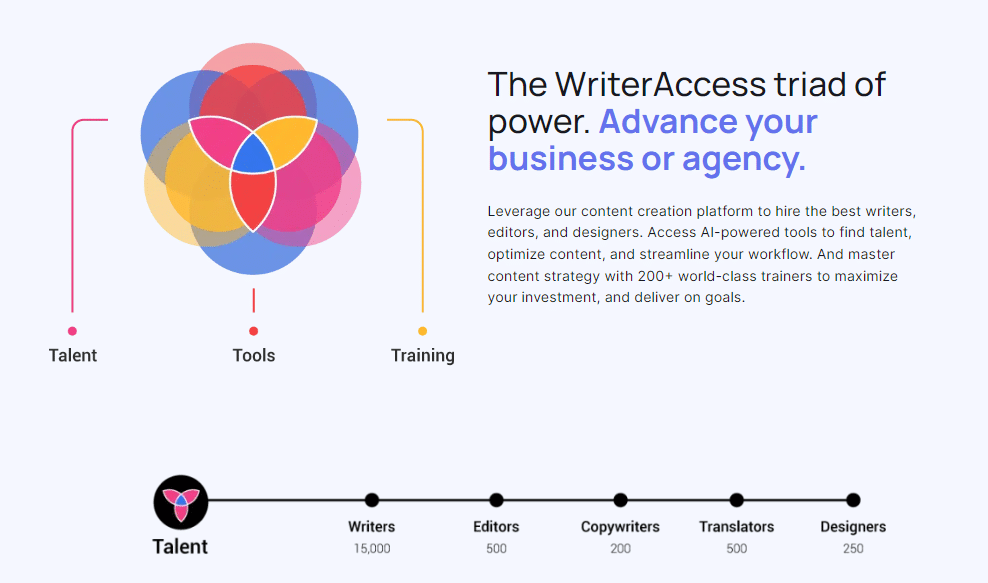In many ways, the internet’s integration into daily life has proven to be a jackpot for content marketers.
Over 90% of businesses say content is a valuable asset. However, only 20% say they know how to run a successful content marketing campaign.
This means there’s plenty of room for winning content to stand out. Mastering content creation can be the key to long-term success for your brand.
- What Is Content Creation?
- The 5 Best Practices of a Content Creation Strategy
- AI for Content Creation, Is It a Good Choice?
- Content Creation Mistakes to Avoid
- 10-Step Content Creation Strategy
- Types of Content to Create
- Examples of Social Media Platforms and the Content That Works Best for Them
- 5 Tools that Make Content Creation Easier
- Analyze Your Content Performance
- How To Manage Content Creation Efficiently
- Wrap Up
- Content Creation FAQ
Download this post by entering your email below
What Is Content Creation?
Content creation is the process of developing various forms of media, such as articles, videos, or images, with the purpose of conveying your ideas, information, and perspectives to a specific audience.
Text content is perhaps the most commonplace. This includes blog posts, social media posts, e-books, white papers, and emails.
Videos and images are also effective content forms. They help you showcase a message that may be hard to explain using only words. Audios are yet another outstanding content option.
In fact, the process of content creation is much more nuanced than simply churning out a webpage and hoping for the best. It requires a lot of research, strategy, and planning.
While discussing the intricacies of content creation, it’s essential to remember Byron White’s straightforward advice: “Story first, optimization second. Unless your story is compelling, no one’s going to read it. It doesn’t matter how well it’s optimized.”
The 5 Best Practices of a Content Creation Strategy
To reap the benefits of the time, effort, and money you put into the process, it’s important to use best practices to develop a winning strategy.
So, without further ado, let’s check out some of these tactics and how they can help take your content creation to the next level.
1. Set Your Goals
As with anything else in life, it’s hard to measure success unless you know what you’re shooting for in the first place.
That’s why it’s important to understand exactly what it is you want your content to do.
Maybe you want to increase brand awareness or the number of leads your company gets each month. Or perhaps you want to boost conversions and overall revenue?
Once you have an idea of what you’d like to do, then it’s time to get a bit more specific about your content creation goals.
Do you want to increase your newsletter subscribers by 100%? If so, by when? Looking to attract more unique visitors to your website each month? Excellent, but get specific about how many.
2. Check Out the Competition
We get it. One of the hardest things about setting content creation goals can be drawing the line between overly optimistic and underlay ambitious goals.
A great way to keep things realistic is to start by benchmarking your competitors. How much traffic are they pulling in and how does it compare to your own?
What strategies and keywords are they using that could help explain their success?
Don’t worry if your next question was somewhere along the lines of “how am I supposed to know?” Tools like Semrush can give you access to this information with a button click.

3. Audit Your Content
Gaining access to your competitors’ stats is great, but it won’t mean much unless you can compare them to your own.
That’s why it’s so important to assess the performance of your current content. Performance analysis with Google Analytics can get you up to speed on how many page views and returning visitors your content generates.
It can also reveal the average amount of time your readers stick with you and the average number of pages they peruse per session.
You may use different metrics depending on the format of the content in question. But the bottom line is that figuring out what isn’t working is an important part of content creation.
It can tell you if it’s time to do a little spring cleaning and specify the best places to start.
4. Know Your Audience
Want to know one of the biggest secrets of content creation? It’s not about you or even the product or service you’re offering.
The key to producing the best content is understanding that it’s all about your customer, their problems, and how you can help solve them.
Understanding this foundational truth can mean the difference between coming across as a used car salesman or a helpful friend with awesome advice.
While it may be tempting to think that everyone with internet access is the ideal buyer, this is simply not the case.
It’s only by gaining a thorough understanding of your exact target audience and the problems they need help solving that you’ll be able to connect with them in the most relatable way possible.
5. Understanding SEO Optimization
Now that you’ve set your goals, studied the tactics of your competitors, and identified your target audience, it’s time to plan out your optimization approach.
Take a look at SEO keywords and phrases that have proven the most successful for your competitors and pick one or two to focus on.
Keep in mind that it’s important not to go crazy here. This common content creation trap has claimed far too many digital marketers as its own.
In an attempt to up their Google rankings, many misguided marketers will attempt to cram every single relevant SEO keyword into their copy as many times as possible.
Google itself has made it clear that this does not work and may hurt you. The goal is to utilize keywords, phrases, and ideas naturally while approaching your topic in the most thorough way possible.

AI for Content Creation, Is It a Good Choice?
In 2024, AI is advancing at a pace unseen in the past. Programs like ChatGPT and Jarvis make it easier for brands and individuals to pump out content rapidly.
However, even though it seems like a new AI platform is unveiled every day, there are some limitations and factors to consider when using these programs. Let’s break them down.
Misinformation
One of the more curious quirks of AI software is when it “hallucinates.” When this happens, the program spits out either slightly incorrect or flat-out false information.
The reason is that AI isn’t technically “learning” information. Instead, it searches for content related to the query and then generates its answer based on that content.
Unfortunately, when AI scans the internet, it can find data from disreputable or misleading sources, affecting the results.
Also, in the case of something like ChatGPT, the existing information pool may be limited. In this case, ChatGPT only has data up to 2021, so if there are updated details about a topic, it won’t be able to use that in its response.
Overall, it means that you should fact-check all AI-generated content. Even if your piece isn’t technically fact-based, verifying that the answer is based on correct ideas is still wise.
Remember that this problem will only worsen as more sites publish AI content without verifying its validity. Programs will cannibalize the same information, leading to a circular logic problem that can become hard to untangle.
Style
If you read content generated by AI software and compare it to something written by a human, it’s pretty easy to tell which is which. Even programs that tout “human-like language” have some significant limitations.
Again, the issue lies with the fact that the program isn’t learning as much as it is collecting and curating information.
A lot of AI content is repetitive and simple. If an English teacher were to read it, they would likely grade it as a solid C.
So, if you want your content to stand out, you need a writer who can add some flair and personality to the text on the page. Otherwise, your content will sound repetitive and boring, sinking reader engagement.
Insight and Expertise
Here is where AI struggles to generate meaningful content. Since the program is technically regurgitating words, it doesn’t understand what it’s saying.
Also, it may not comprehend certain nuanced meanings that a human can understand.
For example, an AI model was used to detect skin cancer in images. While it was accurate most of the time, the program learned to flag photos that included a ruler. Why? Because dermatologists use rulers to measure the lesions for scale. So, rather than analyzing the photo itself, the software determined that all images with rulers depicted skin cancer lesions.
One aspect of AI content you must watch out for is laziness. Machines and programs are all about efficiency and finding the shortest possible route to reach the desired outcome.
While the use of AI software can work for projects like large-scale data management, content outline, or idea generation, you will need human help generating high-quality, meaningful content for your audience.
Content Creation Mistakes to Avoid
While it can be exciting to start producing content, there are plenty of pitfalls and obstacles you can encounter on the way.
Make sure to avoid these mistakes so you can maintain momentum and build an audience faster.
Posting Infrequently
While it’s impossible to say how often you should post, it should be at least once or twice a week, depending on the kind of content you’re producing.
On top of a set publishing schedule, you also want to engage with your audience on social media daily.
While you don’t have to spend hours online every time, you shouldn’t neglect your followers, either.
Always Following Trends
While trends can help inform your content creation schedule, you also want to focus on building valuable evergreen content that your audience will always enjoy.
Ideally, you can have a mix of timeless and trending pieces, so your feed is always fresh and engaging.
Not Following a Plan
One problem many creators face is a lack of a cohesive action plan.
All too often, creators just start publishing pieces and trying to see what sticks.
This strategy never works because it takes time to build an audience, so it’s easy to give up when you’re not getting clicks immediately. Instead, create a plan and stick to it (while tweaking it slightly based on data).

10-Step Content Creation Strategy
Whether you’re running a business or want to create and monetize your own content, you need a comprehensive action plan in place.
So, let’s break down the 10 steps necessary to turn your interactive ideas into high-quality content.
1. Define your target audience.
Who are you developing content for?
For example, a blog post aimed at tech professionals will look and be worded differently from one aimed at single mothers with young children.
Rather than try to create content for “everyone,” it’s much better to pick a specific niche and write to them.
Not only is it easier to gain traction, but niche content can help you stay focused.
2. Set your goals
What do you hope to achieve with your content?
If you’re a business owner, you may want to increase your conversion rate or raise brand awareness.
If you’re a content creator, your primary goal may be to amass an audience, so you can monetize your work.
It’s essential to quantify these goals, so you know whether you’re hitting them or not.
One example could be to set a goal to get 100 comments and 1,000 shares for a single video. Once you reach that goal, set another.
3. Understand content limitations
What kind of production infrastructure do you have?
Do you have access to video equipment, microphones, and lights?
Or are you trying to start with a text-heavy blog and develop new content down the road?
Start with what you’re best at, and then incorporate other content types as you build your audience.
You can also get feedback on what your followers want to see next.
4. Create high-quality and engaging content
When it comes to content marketing, quality always trumps quantity.
Yes, you need to be able to maintain momentum with a consistent posting schedule, but two high-value pieces are going to outperform 10 mediocre ones.
Overall, don’t just produce content to have something for the feed.
Make sure each piece has a purpose and fits in with your larger marketing goals.
5. Determine which platforms work best
Just because there are multiple social media platforms doesn’t mean you have to use them all.
For example, your content may be well-suited to Instagram and TikTok, but not so much to Facebook or Twitter.
Instead of wasting time on platforms that won’t generate results, focus your attention on those that will move your needle.
6. Build a content library
Ideally, you can have multiple pieces ready to go as soon as you launch your page.
This way, you can build up a buffer, and you’re not under pressure to produce new material every week or month.
Start with core content pieces that address the foundations of your brand.
From there, you can branch out further into your niche and explore different perspectives.
7. Develop a content schedule
Some content creators like to produce a new piece every day, while others may opt for once a week.
There is no “right” answer, but you want to make sure you don’t wait too long between content releases.
Otherwise, it’s hard to maintain momentum and build an audience.
It’s also best to start small (i.e., twice a month) and then add more content as you streamline the process.
8. Optimize content for each social media platform
Social media marketing is so effective because you can boost your brand quickly on each platform and via search engines.
In some cases, a business’ Facebook page may rank higher than its website.
So, be sure to optimize all of your content with keyword-friendly captions, transcripts, images, and more.
Each component is valuable, so don’t just create a cool title and think that’s sufficient.
9. Use keyword research to generate new ideas
One of the primary challenges of social media content creation is coming up with ideas over the long term.
Keyword research can tell you what your audience is searching for, so you can create pieces to address those questions. Then, you can develop a content plan accordingly.
10. Pay attention to social trends
Trending topics can shift on a dime, and they’re constantly changing based on numerous variables.
While it’s impossible to know what will be trending at any given time, you can still jump on them as soon as they develop.
In this case, you’ll need a streamlined content production system to capitalize on trends before they fizzle out.
Types of Content to Create
Knowing what types of content to create is vital for successful content marketing. Content can be organized into categories such as blog posts, videos, infographics, interviews, podcasts, webinars, and articles.
Depending on the purpose and goals of your content strategy you may choose to create multiple types of content or focus on one type at a time.
Below are some of the best types of information to include in your content creation strategy. These can be used to share your expertise and engage with potential customers.
Articles on Blogs
Blog articles are one of the most popular types of content. They are generally informative, easy to read, and shareable. When writing blog articles, be sure to include relevant keywords, catchy headlines, and engaging graphics.
Guest blogging on other websites is also a great way to get your message out there and build relationships with other thought leaders in your industry.
Some of the many benefits of including articles include:
- SEO optimization: Using keywords in your articles will increase traffic to your website.
- Engagement: Articles that are interesting and informative can help to engage readers.
- Authority: Sharing your knowledge and expertise can help to build your brand as an authority in your industry.
Videos
Videos are an excellent way to engage and educate your audience. They can be used to share company updates, product features, or interviews with experts in the field.
Videos are also a great way to showcase customer success stories and demonstrate how your products can solve their problems.
When creating videos, be sure to include captivating visuals, clear audio, and an engaging narrative. In addition, don’t forget to optimize meta descriptions, tags, and titles so the videos are easily searchable and help your website rank higher.
Infographics
Most industries agree that 52 seconds is a good time to spend on websites. Since people browse websites for less than a minute, capturing the attention of viewers quickly is critical. Infographics are great for this purpose, as they are visually appealing and easily digestible. They can be used to show statistics, illustrate trends, or explain complex ideas.
Infographics are especially beneficial for social media platforms like Facebook and Instagram, as they can be quickly consumed and shared by viewers.

Social Media Posts
Social media is a powerful tool that is vital to your content creation strategy. An estimated 82% of consumers use social media to make their purchasing decisions. This makes it a great platform for sharing content and engaging with customers.
When creating social media posts, be sure to include visuals, hashtags, and captions that are succinct but informative. It is also important to use relevant keywords so that your posts can show up in organic search results.
In addition, social media posts should be targeted to specific audiences. For instance:
- Instagram: Use vibrant visuals and short captions to tell a story for younger audiences and millennials, which make up over a quarter of users.
- Facebook: Focus on engaging content that encourages shares, comments, and likes.
- LinkedIn: Stress the professional elements of your message with long-form posts or thought leadership articles.
- Twitter: Short Tweets with relevant hashtags can help to drive more traffic to your website.
Guides, e-books, and Whitepapers
Whitepapers, guides, and e-books are a must for those looking to promote thought leadership and build an audience. They are longer-form pieces of content that discuss complex topics in detail and demonstrate your expertise.
These types of documents require more work than other forms of content creation, but they can also be very effective at engaging readers and driving conversions. When creating guides, e-books, or whitepapers, be sure to use visuals to engage your audience, as well as conduct multiple reviews.
In addition, you can always optimize your e-books on platforms such as Amazon, which you can then link back to your site. These longer-form documents can also generate leads as users are often required to provide their information to view your content.
Checklists
Everyone loves a good checklist. Checklists are great for providing readers with helpful tips and reminders that they can use to achieve their goals.
When creating a checklist, be sure to include key points such as:
- Actionable steps
- Process-oriented tasks
- Helpful advice that users can refer back to
Some checklists can even be filled out online so you can make the process much easier. Checklists can include anything from recipes to packing lists, to travel guides. Here’s one example of a checklist by Rock Content:

Regardless of the format you choose, checklists are a great way to help readers quickly understand and complete tasks. They are also helpful for SEO purposes, as people often search for such resources online. Add keywords such as “Travel checklist,” or “Packing list” to optimize your content for search engines.
Influencer Marketing
Influencers are people who have a large platform and can effectively influence the purchasing decisions of their followers. They are often seen as trustworthy sources of information and can play an important role in content creation.
When creating influencer-based campaigns, be sure to research potential influencers carefully. Look at their engagement rates, follower numbers, and the number of likes and comments their posts receive.
Another important factor is to ensure that their style and content are a good fit for your brand’s message. Once you have identified potential influencers, create an agreement outlining the deliverables and any compensation that will be provided. Influencer marketing can be an effective way to reach new audiences and build brand awareness.
Podcasts and Webinars
Podcasts and webinars are a great way to reach audiences through more than just written content. For podcasts, you can create audio versions of your blog posts or interviews with industry experts. Webinars are also a great way to engage audiences through live events and Q&A sessions.
When creating podcasts and webinars, always keep in mind who your target audience is and tailor the content accordingly. Make sure to use visuals and engaging topics to keep listeners interested. You can also consider partnering with other brands or influencers who can help to promote your content.
Success Stories
Lastly, success stories are a great way to showcase your product or service and inspire potential customers. Customers love hearing from real people who have had success with your offerings.
You can create case studies that tell the story of how you solved a customer’s problem, or ask customers to provide their own stories in the form of written articles or interviews. You can also create video testimonials that highlight the success of your customers.
By creating these types of content, you can help to build trust with potential customers and demonstrate your value.

These are just a few of the different types of content that you can create to engage audiences and help drive conversions.
Consider experimenting with other formats to find the right one that works for your business. If you need help with content creation, WriterAccess is here to help!
Our team of writers and digital artists can help you create different types of content to help improve rankings and make your business thrive! Check out our two-week trial period today.
Examples of Social Media Platforms and the Content That Works Best for Them
You’ve likely interacted with most of these social media channels already, but may not have thought about them from a content creator perspective.
Here’s an overview of the primary platforms and the type of content that works best for each.
Despite recent negative headlines, Facebook remains one of the titans of the social media industry.
This platform still resonates with audiences because it’s an all-in-one resource for content creation.
You can post videos, images, and text posts on Facebook, and these posts can all earn engagement from your audience.
Overall, Facebook is a great foundation for all your content, then you can promote specific pieces on other channels to broaden your reach.
Instagram started as a simple photo-sharing platform, but it’s quickly transformed into a home for video content as well.
While Instagram lags behind other video-focused channels like TikTok in terms of the total number of viewers, its Stories and Reels are still a solid alternative to static images.
Plus, its IGTV service allows content creators and businesses to connect with audiences via live streaming for a more personalized, immediate approach.
Although Twitter has undergone quite a shakeup behind the scenes, the platform is still valuable for content creators and businesses alike.
As a text-based channel, brands can get the most traction by crafting memorable and clever Tweets, including individual messages and conversation threads, or embedding GIFs for visual treats.
Twitter is also great for sharing links to landing pages or blog posts.
Blogs
For some, blogs may not seem technically like “social media.” However, while blogs aren’t connected to a wider network, they can be perfect for starting a conversation and engaging with your audience.
Better yet, because you’re in control of your blog on your own website, you can manage these interactions and turn them into calls to action.
Plus, blog posts are perfect for sharing across different channels like Facebook, Twitter, and others.
5 Tools that Make Content Creation Easier
Coming up with ideas is the easy part – creating content is much harder.
Fortunately, we’re living in a golden age of content creation, so there are tons of tools at your disposal.
Best of all, most of these options have free versions, so you can start building your library without a significant investment.
WriterAccess
Instead of spending time writing your blog or landing page content, why not outsource the work to high-quality writers across dozens of industries?
On WriterAccess, you just provide the information, and you’ll receive SEO-friendly writing that will help convert leads into loyal fans.
Not only that, you’ll have the help of AI tools to generate ideas, identify content created by Artificial Intelligence and find the best writer for your projects.

Ion
Ion is a full-service package that allows you to build various content pieces that can combine to create a cohesive buyer’s journey from start to finish.
Plus, it uses a super-easy interface, so anyone can master content creation, all without needing to learn coding or programming.
Canva
When it comes to professional graphic design, nothing beats Adobe Photoshop and Illustrator.
However, Canva makes these tools accessible to everyone, even if you have no graphic design experience.
You can find tons of templates and tutorials on how to make your content pop.
Hootsuite
Managing your content schedule can easily become a full-time job, especially if you’re posting to multiple channels.
Hootsuite allows you to schedule pieces for publication ahead of time, and it integrates all of your channels into a single dashboard.
So, you can spend a few hours here every week and maintain consistency.
Lumen 5
Video content is king, and Lumen5 allows you to create captivating videos without studio or camera equipment.
You can utilize tons of templates and stock video footage to craft anything for virtually any industry.
While Lumen5 doesn’t work for customized content creation, it’s valuable for businesses that want to post more often.
Google Trends
One of the best ways to capture an audience on social media is to play into current trends.
Google Trends can show you the trends for specific keywords.
This way, you can see if they’re trending up or down, and you can even see where interest is spiking around the country.
Google Trends has tons of data points to utilize, so you can make sure your content is as engaging as possible.
BuzzSumo
While Google Trends gives you raw data, BuzzSumo helps you turn information into an action plan.
This cloud-based app can give you valuable insights into various high-engagement topics, so you’re always capturing the most engagement.
The app can even guide you through how to use it for maximum results.
BookWidgets
If you are creating content specifically for educational purposes, then BookWidgets helps you create and evaluate content such as quizzes and worksheets and helps you give personalized feedback, too.
Analyze Your Content Performance
Social media platforms often come with analytical tools that can tell you everything about who’s engaging with your content.
Pay attention to elements like time of day, location, and demographic data.
For example, you may determine that mornings are best for engagement, so try to post earlier in the day.
Or, you may realize most of your audience is from a specific geographic area, so you can create location-specific content.
How To Manage Content Creation Efficiently
You may have tons of content ideas and plenty of resources to create them, but where do you start, and how can you streamline your creation process? Here are some tips and tricks to take you from content overwhelm to efficient productivity.
Have a Content Schedule
There is no “right” amount of content to publish to your audience. For some businesses, publishing one piece a week is enough to engage with customers and generate sales. Other brands may need to publish daily to ensure better growth and marketing momentum.
Still, you must start somewhere even if you’re unsure how much content to generate. A schedule can help you build a solid foundation to leverage your marketing opportunities. For example, you can post a blog article every Thursday and a video piece twice a month.
Once you have a plotted schedule, you can adjust it as necessary. Also, remember that you don’t have to fill in the details of each piece right away. For example, you know you need four blog posts for the following month, but you can decide later on topics to generate the most interest.
Monitor Trends
Evergreen content is always ideal because you can publish and re-publish it in the future for maximum exposure and engagement. However, you should also be capitalizing on current events and trends to boost your content marketing from time to time.
Also, remember that trending topics tend to fizzle out pretty fast, so you have to be quick to take advantage. For example, if there’s a viral challenge, you should push that to the top of your content creation schedule so you can post it within a couple of days (or hours in some cases).
Analyze Results
Marketing analysis is the best way to determine what is working and what isn’t. Content creation can take a lot of time and energy, so you want to ensure you get the best return.
That said, analysis is usually a long-term strategy. All too often, brands try a variety of content pieces and then get frustrated when it seems like nothing is working. Instead, sticking to a schedule and maintaining consistency with content generation is a better way forward. As long as the content is valuable to your audience, it will find its way to new customers eventually.
Once you have some metrics to work with, you can then adjust your creation strategy accordingly. For example, posting at a different time of day may get better engagement. Similarly, certain topics may get noticed faster than others, so you can focus more on those.
Focus on Quality, Not Quantity
Finally, getting your content noticed by the masses can seem virtually impossible. With so much competition from other companies and individual creators, it’s easy for your pieces to get lost in the vortex.
While it can be frustrating at first, you want to avoid assuming you must blitz your audience with as much content as possible. Not only is that strategy unsustainable, but it can also alienate your followers and make them avoid your brand altogether.
Instead, it’s best to focus your energy on creating the best content possible. If you can do that quickly and consistently, great. If it takes time to produce a high-quality piece, don’t rush it.
Also, consider that you can post different kinds of content on various channels. So, you can create shorter pieces to fill in the gaps between more substantial content. As long as your content creates value for your customers, it should generate buzz, even incrementally.
For now, humans still produce the best results when creating content, and you should take advantage of that. The Writer Access platform connects you with writers worldwide who can create customized pieces that fit your brand.
Regardless of the industry or size of your business, WriterAccess has one of the largest talent pools online, so you will find someone exceptional to work with. Plus, with intuitive back-end controls and excellent customer service, you can get your content creation schedule up and running fast.
Start your free two-week trial today!

Wrap Up
Now that you’ve mapped out a plan for the content you want to create, it’s time to get things up and running. Unless you are a professional content creator, this is often the point where you’ll want to do a little outsourcing.
If your toilet was overflowing, would your first instinct be to spend all day googling DIY plumbing techniques? For the sake of everyone in the toilet’s vicinity, we’d hope not.
More than likely, you’d call a professional plumber. Content creation is no different.
Plenty of great folks do this kind of thing for a living, so why not enlist their help? Think of this stage as running your digital agency, complete with freelance writers, designers, and anyone else you need to achieve your content goals.
Sound intimidating? Don’t worry because there’s no need to do it alone. WriterAccess is all about helping you streamline your content, with access to pre-screened, industry-leading freelancers.
You’ll also discover powerful tools you can use to analyze and optimize your content, as well as free training resources to help you stay at the top of your content creation game. Try it free for 14 days!
Content Creation FAQ
How do I start content creation?
Starting content creation involves several foundational steps:
- Identify Your Purpose: Determine why you want to create content and what goals you aim to achieve.
- Know Your Audience: Understand who your target audience is—their interests, preferences, and needs.
- Choose Your Platforms: Select the channels (e.g., blog, social media, YouTube) where your audience is most active.
- Develop a Content Plan: Outline topics, formats, and a publishing schedule to maintain consistency.
- Create and Publish: Begin producing content that provides value, educates, entertains, or solves problems for your audience.
What are the 5 Cs of content creation?
The 5 C’s of content creation are crucial principles to follow:
- Clarity: Ensure your message is clear and easy to understand by your audience.
- Consistency: Regularly produce and publish content to maintain engagement and build a loyal audience.
- Creativity: Use original ideas, unique perspectives, and compelling storytelling to captivate your audience.
- Context: Tailor your content to fit the platform and the specific preferences of your audience.
- Call to Action (CTA): Prompt your audience to take the next step—whether it’s liking, sharing, commenting, subscribing, or purchasing.
What are the key pillars of content creation?
The key pillars of content creation include:
- Strategy: Develop a clear plan aligned with your business objectives and audience needs.
- Quality: Create content that is informative, relevant, and valuable to your audience.
- Distribution: Utilize appropriate channels to reach your target audience effectively.
- Engagement: Encourage interaction, feedback, and sharing among your audience to build community and loyalty.
What are the 3 R’s of content?
The 3 R’s of content refer to:
- Reuse: Repurpose existing content into different formats (e.g., turning a blog post into a video or podcast).
- Repurpose: Adapt content for various platforms and audiences while maintaining its core message.
- Recycle: Update and refresh outdated content to keep it relevant and useful over time.
What are the most important 4 factors to create great content?
The most important factors for creating great content include:
- Relevance: Address topics that resonate with your audience’s interests and needs.
- Quality: Deliver well-researched, accurate, and valuable information or entertainment.
- Engagement: Encourage interaction, comments, and shares to foster community and increase reach.
- Consistency: Maintain a regular posting schedule to keep your audience engaged and coming back for more.
How to master content creation?
To master content creation, focus on continuous improvement:
- Learn and Research: Stay updated on industry trends, audience preferences, and effective content strategies.
- Practice and Experiment: Try different formats, styles, and approaches to see what resonates best with your audience.
- Analyze and Optimize: Use analytics to measure the performance of your content and refine your strategies accordingly.
- Seek Feedback: Listen to audience feedback and adapt your content based on their responses and engagement.
What is the formula for content creation?
While there’s no one-size-fits-all formula, a successful content creation approach typically involves:
- Research: Understand your audience and what content they find valuable.
- Plan: Develop a content strategy and editorial calendar.
- Create: Produce high-quality content that meets your audience’s needs.
- Promote: Distribute your content through appropriate channels to reach your target audience effectively.
- Evaluate: Measure the performance of your content and iterate based on insights gained.








